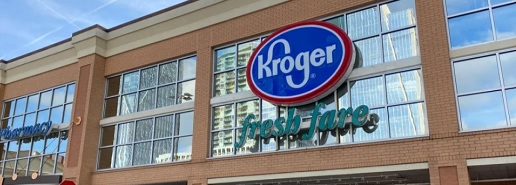Kroger: Pioneers in Data-Driven Grocery

Believe it or not, major grocery stores are on the leading edge of using data analytics to manage daily operations. And among them, Kroger leads the pack.
Picture this: You’re on your way home from work, windows down, Taylor Swift blasting, when you realize: Oh no! You’re missing that key ingredient for dinner tonight! Lucky for you, your supermarket is ahead. Well, it’s not the location you go to every week but it’s the same brand of store. It’ll do.
You park and hustle into the store with fierce determination to not add more than 4 minutes to your trip home. You make a beeline for Aisle 6—you’ve bought diced tomatoes so many times that you’ve memorized its precise location. Except when you turn the corner to Aisle 6, it’s not the canned vegetables aisle at all…it’s the Asian foods aisle?! You weave your way through the labyrinthine store until you find the canned vegetables—but there are no tomatoes?! Dangerously close to the 4-minute mark, you flag down a disinterested employee who tells you that diced tomatoes are with the Italian foods, Aisle 12. Why would diced tomatoes be in a radically different place in two stores located only 2 miles apart?
And who’s to blame? You guessed it—data analytics.
Believe it or not, major grocery stores are on the leading edge of using data analytics to manage daily operations. And among them, Kroger leads the pack.
The Kroger Company is the largest supermarket operator in the US, with over 2,700 stores across 35 states. The company has long branded itself as an innovator, adopting new technologies like electronic scanners and checkout software faster than any other grocery chain, [1] and the same applies to their approach to data. CEO Rodney McMullen recently touted Kroger’s approach to data as the company’s “competitive moat,” saying, “Many retailers have transactional data, but no one has the customer data and the insights that Kroger has.”[2]
Big data and analytics power a surprising degree of the grocery shopping experience. For example:
- Ads and Promotions: Loyalty programs enable Kroger and others to offer personalized recommendations and promotions to customers. For example, through their MyMagazine program, Kroger tailors mailed circulars to the unique shopping habits and preferences of each participating household. In fact, “Kroger claims to have delivered half a trillion personalized recommendations to customers in 2020…. [and] the company’s email open rate is nearly 18 percent higher than the industry average.”[3] This ability drives incremental revenue and, in turn, makes Kroger a more attractive retail partner for suppliers and advertisers.
- Inventory Management: Macro and micro analysis of customer purchases enables Kroger to better predict and respond to shifts in demand. For example, Kroger recently noted that high inflation during and after the pandemic has driven more customers to private label instead of national brands. As a result, it launched 239 new private label products in Q1 2022.[4]
- Product Placement: Kroger and other retailers use complex analyses and even customer heat maps and eye-tracking maps to optimize the location of aisles, food categories, and even specific products within its stores. As illustrated in our fictional example, the result is often that inventory is organized slightly differently from store to store, each location tailoring its placement to the unique preferences and psychology of its customer base. Not only does this improve customer experience and increase customer sales, this practice also allows Kroger to charge suppliers more in slotting fees for prime in-store or on-shelf real estate.
To facilitate data collection, analysis, and deployment, Kroger acquired DunnhumbyUSA, a data science company, in 2017.[5] Renamed after the Kroger HQ’s longitude coordinate, 84.51 is the engine that enables Kroger’s data-driven approach to retail. It also provides an additional revenue stream: its Collaborative Cloud product, for example, provides “24/7 access to clean, unaggregated, transaction-level data for 60 million de-identified households, updated weekly, in a privacy-compliant, hosted environment that has been built to an individual company’s specifications and data needs.”[6]
Kroger’s data-driven approach hasn’t come without challenges. Most notably, ownership of massive quantities of customer data has made the company a target for cyber-attacks. That’s exactly what happened in 2020 when hackers broke into Kroger’s pharmacy data, stealing health records for 3.8 million customers and employees. A class action lawsuit on behalf of the victims resulted in months of legal deliberations before arriving at a $5M settlement.[7]
But while these and other challenges persist, Kroger maintains that its approach to data is the company’s competitive advantage and continues to pave the way for new applications of behavioral insights in retail.
[1] https://www.thekrogerco.com/about-kroger/history/
[2] https://www.winsightgrocerybusiness.com/retailers/kroger-execs-highlight-competitive-moats-q3-review
[3] https://retailwire.com/discussion/kroger-ceo-says-no-one-has-the-data-and-insights-that-it-has/
[4] https://www.pymnts.com/earnings/2022/kroger-leverages-data-analytics-in-the-fight-against-inflation/
[5] https://www.adexchanger.com/data-exchanges/kroger-acquires-dunnhumby-data-assets-from-tesco-forges-new-venture/
[6] https://chainstoreage.com/kroger-opens-transaction-level-data-cpg-brands
[7] https://www.reuters.com/legal/litigation/kroger-agrees-pay-5-million-over-accellion-data-breach-2021-07-01/


